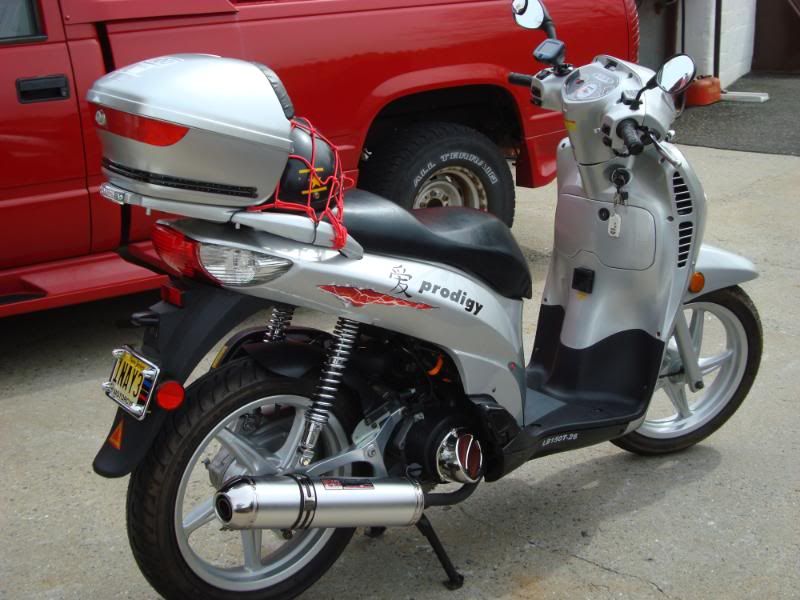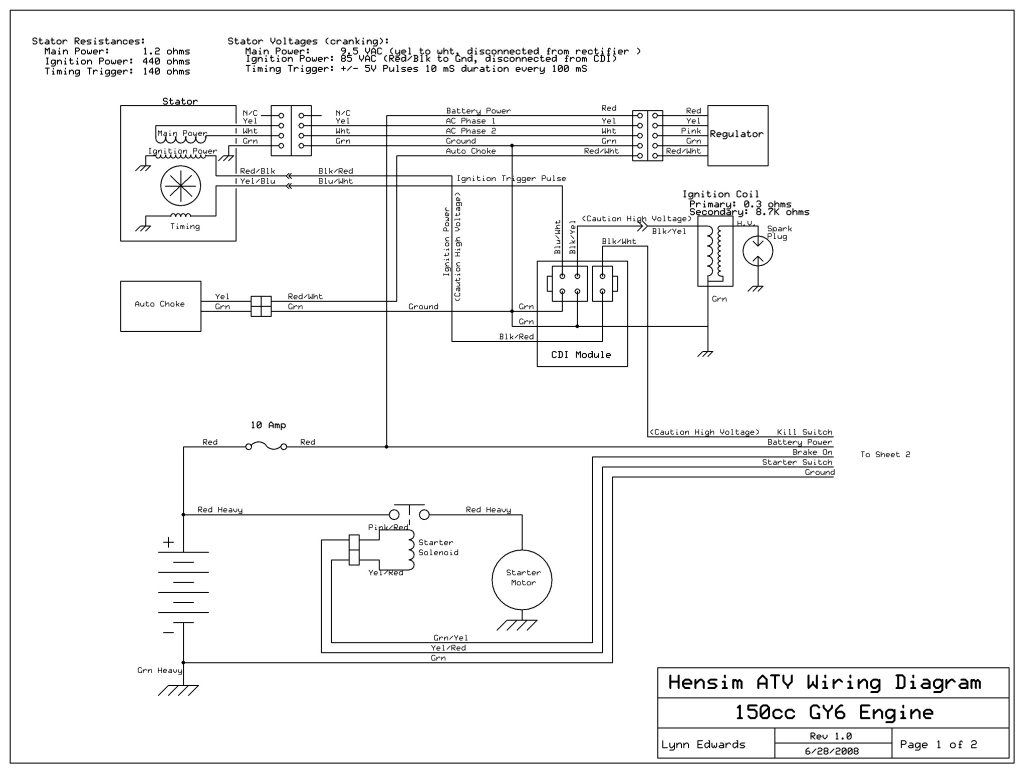Post by noday on Jun 17, 2011 12:54:06 GMT -5

I want to publicly thank Rebel for providing the wiring diagrams and other support in this project.
How to convert a 50 or 150 GY6 scooter to 12V DC.
most GY6 based scooters use a mixed AC-DC electrical system.
The 12V DC side is used for some of the lights ( brake and turn signal/flasher lights ), gas gauge, the electric starter and to recharge the battery.
The spark plug ignition is AC powered from a single pole of the stator and is independent of the 12V DC and the AC lighting circuits.
The headlights, tail lights and running lights are AC powered.
Another way to logically separate AC and DC lights is: lights controlled by the key switch are DC.... lights that come on only when the motor is running are AC. There is always some variation from scooter to scooter.
The 12 V DC wattage in the stock electrical system is quite limited. 6 pole stator ::: 30 to 50 watts... 8 pole ::: 50 to 70 watts. the regulated 12V DC does not have enough supply wattage to run a high intensity (HID) headlight and to keep the battery charged enough for the electric starter to work.
A drawback of AC is that you can not run HID or LED bulbs from AC
a link about theory of how a 12 V DC system works on a scooter with stator generated AC electrical power.
trailtech.net/media/electrical/dc_conversions/ac-dc_key_concepts.pdf
you will need to make some changes in the wiring so that all the lights run from the battery. you will also need to install a switch for the 12 V lights, other wise headlights will draw too much current and the starter will not be able to crank the motor. make sure the switch can carry the amp load.
A 12 V DC system basically runs every thing from the battery. The stator and regulator rectifier keeps the battery fully charged ...... more or less how most cars work.
you may need to increase the wire size for the headlight circuit. One advantage to AC for high amp draw lights is that AC can use a smaller size wire than 12 V DC. If the load is too high for the wire size, the wire will get hot and things will melt.
conversion to a 11 pole stator, flywheel and regulator will also up the 12V regulated wattage enough to run high wattage headlights and LEDs.
the drawback of the 11 pole stator conversion is bolt holes do not always line up correctly. timing may be off because of a different location of the trigger coil pole on the stator and expense. 3 components must be changed: stator, flywheel and RR. cost in the $150 range. The 11 pole is more likely to fit a gy6 150 than a 50.
an alternative modification is to use a Trail Tech Full Wave regulator rectifier (150 watts) and modify your current stator to work with the TT. The watt rating is maximal rated output. it does not mean you will get that many usable watts. ( usable watts will depend on the stator output )
www.trailtech.net/7003-RR150.html about $45
The trail Tech RR is available from several online retailers, as well as Ebay and Amazon
the stock GY6 regulator rectifier / stator electrical system is usually single phase 1/2 wave. Only 1/2 of the AC stator output is converted to 12 V DC.
The TT RR is a full wave RR and outputs 2 X the 12V wattage from the AC input compared to the stock GY6 1/2 wave RR. You should get about 80 usable watts with a 6 pole stator and 100-110 watts with a 8 pole.
The 8 pole stator conversion gives total usable watts similar to an 11 pole, with some differences. The 12 V from the 8 is not as smooth as the 11. the 11 gives better amps at low rpms.
the conversion will work without a battery but the voltage will be spiky and may burn out the odd component due to poor voltage control. at least one guy burned out the TT RR running without a battery.
a battery or capacitor is used to smooth the DC voltage if you want to power any electronic devices such as a GPS, video cam, etc.
you can not just swap a full wave RR for the stock GY6 RR as the internal wiring of a stock stator must be modified to produce a floating full wave output.
the convention in wiring colors for stator output is: yellow carries the AC. a stock GY6 stator has 1 yellow ( AC ) wire paired with ( ? white )
The TT RR requires that the stator AC output not be strapped to ground but to "float"
The TT RR has 2 yellow AC inputs from the stator and 2 12V DC connections ( red & Black ) to the battery plus a 3rd blue (used for 4AH batteries ).
The instructions & wiring guide for the TT RR are here:
www.trailtech.net/media/instructions/lights/regrec/010-ELV-71.pdf
Instructions for stator conversion are here:
trailtech.net/media/electrical/dc_conversions/ktm_dc_conversion.pdf
you swap some connections ( wire ends ) on the stator and add a 2nd yellow wire ( to keep with the convention of yellow wire = AC )
----------------------------------------------------------------------------
There is more to the conversion than just the stator conversion and RR swap. the threads below are helpful in sorting out the other mods needed.
more to follow in later posts for details
---------------------------------------------------------------------------
Below are threads on other forums about converting to a 12 V DC system. These threads go back several years & are a mix of posts about 6 8 and 11 pole stators. the posts are usually about 150 GY6 engines.
scootdawg threads
scootdawg.proboards.com/index.cgi?board=talk&action=display&thread=24883
scootdawg.proboards.com/index.cgi?board=talk&action=display&thread=8929
scootdawg.proboards.com/index.cgi?board=talk&action=display&thread=21253
scootdawg.proboards.com/index.cgi?board=talk&action=display&thread=10003
i have read thru the threads several times and the info appears accurate.
It would be nice if there was a single web page with complete information about this, like some of 90GTVert's well done, how to pages.
There is probably one around somewhere, but I have yet to find it.
revised 19jun11, 7aug11








 CAN YOU HELP ME OUT MAN,AS i LOST ME JOB DUE TO NOT BEING ABLE TO GET THERE?ANY INF
CAN YOU HELP ME OUT MAN,AS i LOST ME JOB DUE TO NOT BEING ABLE TO GET THERE?ANY INF